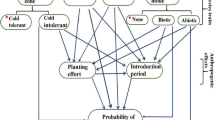Abstract
“Sudden Oak Death” (Phytophthora ramorum) is a non-indigenous forest pathogen which causes substantial mortality of coast live oak (Quercus agrifolia) and several other oak tree species on the Pacific Coast of the United States. We estimated the time path of residential property values subject to oak mortality using a dataset that spans more than two decades—including a decade of transactions before-and-after the invasion. The findings suggest moderate, persistent property value discounts (3–6%) for homes located near infested oak woodlands subject to continuous post-invasion declines in forest health. The most severe discounts (8–15%) occurred where dying oaks were distributed both within residential neighborhoods and in nearby woodlands. Various hedonic modeling specifications were tested and compared to assess their ability to control for bias associated with unobserved spatial effects.
Similar content being viewed by others
References
American Community Survey: Public Use Microdata Sample (2006) US Census Bureau
Anselin L (2002) Under the hood: issues in the specification and interpretation of spatial regression models. Agric Econ 27(3): 247–267
Anselin L (2005) Exploring spatial data with GeoDa: a workbook. Online. Available at http://www.csiss.org/clearinghouse/GeoDa/geodaworkbook.pdf
Anselin L, Bera A (1998) Spatial dependence in linear regression models. In: Ullah A, Giles DEA (eds) Handbook of applied economic statistics. Marcel Dekker Inc., New York, pp 237–289
Anselin L, Bera A, Florax R, Yoon M (1996) Simple diagnostic tests for spatial dependence. Reg Sci Urban Econ 26: 77–104
Chay K, Greenstone M (2005) Does air quality matter? Evidence from the housing market. J Polit Econ 113(2): 376–424
Chow G (1960) Tests of equality between sets of coefficients in two linear regressions. Econometrica 28(3): 591–605
Cropper ML, Deck LB, McConnell KE (1988) On the choice of functional form for hedonic price functions. Rev Econ Stat 70: 668–675
Donovan G, Butry D (2010) Trees in the city: valuing street trees in Portland, Oregon. Landsc Urban Plan 94: 77–83
Frankel S (2010) Forest disease conditions and climate: what’s changed?. Mt Views 2(1): 21–23
Garbelotto M, Schmidt D (2009) Phosphonate controls sudden oak death pathogen for up to 2 years. Calif Agric 63(1): 10–17
Greenstone M, Gallagher J (2008) Does hazardous waste matter? Evidence from the housing market and the superfund program. Q J Econ 123(3): 951–1003
Halvorsen R, Palmquist R (1980) The interpretation of dummy variables in semilogarithmic equations. Am Econ Rev 70(3): 474–475
Hansen EM, Parke JL, Sutton W (2005) Susceptibility of Oregon forest trees and shrubs to Phytophthora ramorum: a comparison of artificial inoculation and natural infection. Plant Dis 89(1): 63–70
Holmes T, Aukemma J, Von Holle B et al (2009) Economic impacts of invasive species in forests: past, present, and future. The year in ecology and conservation biology. Ann NY Acad Sci 1162: 18–38
Holmes T, Murphy E, Bell K, Royle D (2010) Property value impacts of hemlock woolly adelgid in residential forests. For Sci
Horsch E, Lewis D (2009) The effects of aquatic invasive species on property values: evidence from a quasi experiment. Land Econ 85(3): 391–409
Ivors K, Garbelotto M, Vries D, Ruyter-Spira C, Hekkert B, Rosenzweig N, Bonants P (2006) Microsatellite markers identify three lineages of Phytophthora ramorum in US nurseries, yet single lineages in US forest and European nursery populations. Mol Ecol 15: 1493–1505
Kim C, Phipps T, Anselin L (2003) Measuring the benefits of air quality improvement: a spatial hedonic approach. J Environ Econ Manag 45: 24–39
Kuminoff N, Parmeter C, Pope J (2010) Which hedonic models can we trust to recover the marginal willingness to pay for environmental amenities?. J Environ Econ Manag 60: 145–160
Linden L, Rockoff J (2008) Estimates of the impact of crime risk on property values from Megan’s laws. Am Econ Rev 98(3): 1103–1127
Netusil N, Chattopadhyay, Kovacs K (2010) Estimating the demand for tree canopy: a second-stage hedonic price analysis in Portland, Oregon. Land Econ 86: 281–293
Olson L (2006) The economics of terrestrial invasive species: a review of the literature. Agric Resour Econ Rev 35(1): 178–194
Palmquist R (1982) Measuring environmental effects on property values without hedonic regressions. J Urban Econ 11(3): 333–347
Pope J (2008a) Do seller disclosures affect property values? Buyer information and the hedonic model. Land Econ 84(4): 551–572
Pope J (2008b) Fear of crime and housing prices: household reactions to sex offender registries. J Urban Econ 64(3): 601–614
Rizzo D, Garbelotto M (2003) Sudden oak death: endangering California and Oregon forest ecosystems. Front Ecol Environ 1(5): 197–204
Sansford C, Inman A, Webber J (2009) Development of a pest risk analysis for Phytophthora ramorum for the EU: the key deliverable from the EU-funded RAPRA project. In: Proceedings of the fourth sudden oak death science symposium. 17 June 2009
Author information
Authors and Affiliations
Corresponding author
Rights and permissions
About this article
Cite this article
Kovacs, K., Holmes, T.P., Englin, J.E. et al. The Dynamic Response of Housing Values to a Forest Invasive Disease: Evidence from a Sudden Oak Death Infestation. Environ Resource Econ 49, 445–471 (2011). https://doi.org/10.1007/s10640-010-9441-y
Accepted:
Published:
Issue Date:
DOI: https://doi.org/10.1007/s10640-010-9441-y




